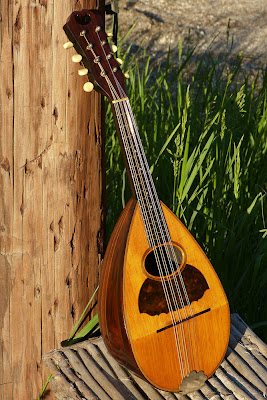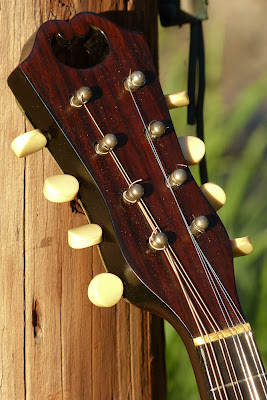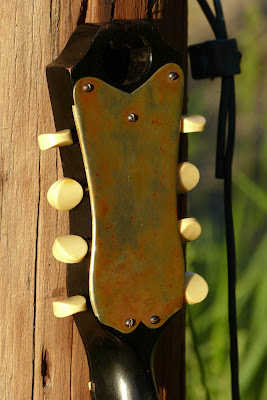c.1905 Siegel Mayflower-style Bowlback Mandolin
Update: I've updated the description.
First off, this is a great old bowlback. Work included a fret level/dress, new (parts bin) bridge, cleaning, and setup -- and it didn't need any more than that. It's in really great shape for its age.
Next, this make of mandolin is hard to pin down as far as the maker goes. It's essentially identical in build to this Mayflower and this Ditson, both of which are very close to Vega (Boston) instruments.
However, lately I've been thinking that this particular style of bowlback was probably built by the Larson Brothers who also made very "Vega style" bowlback instruments right down to finish and binding choices. The differences add up in the overall weight of the neck area (heavier on vetted Larsons) and bracing (also a little heavier) yielding a stiffer-feeling instrument to the touch, but one that still has that lovely creamy sound that I expect on the featherweight Vegas. The neck joint is actually slightly different from what I've seen on actual-branded Vegas.
The instrument speaks for itself with a crisp, clean, and quite loud voice. It's very articulate and especially nice for tremolo leads up to the high end (it's not raspy or harsh as some bowls get, but rather sweet and balanced).
The instrument speaks for itself with a crisp, clean, and quite loud voice. It's very articulate and especially nice for tremolo leads up to the high end (it's not raspy or harsh as some bowls get, but rather sweet and balanced).
The nice spruce top has only one tiny hairline crack at the top of the soundhole going into the fretboard's end. The bracing is sturdy but nicely-carved.
This instrument has a good, thick headstock which accepts those inset-style tuners quite well. The rosewood headstock veneer looks great and the deluxe tuner shafts do as well. Original bone nut.
Nice ebony board with pearl dots.
The top edge is bound in rosewood and both the sides and soundhole rosette have an elegant multi-stripe purfling inlaid.
The pickguard was peeling and had to be reglued for stability. This ebony bridge is quite low but does the job. The geometry shifted on this instrument (like most bowlbacks) to where it needs a lower bridge to get proper action height. Still, there's clearance enough over the pickguard and at the soundhole to play just fine.
The tailpiece still has its cloud cover (miraculously).
The finish shows age and use wear but is in really good shape overall. The 17-rib Brazilian rosewood bowl has no splits or repairs at all, too!
Isn't that gorgeous?
Nice coverplate, but it's showing some tarnish.
The neck is set nicely.
There's the tailpiece.
The only "crack" so to speak is this scrape/tiny chip-hairline along the strapping of the treble side of the mandolin. No issue.
While this bears the Siegel Cooper Co. label, you can see it's "made expressly for" them.


















Comments